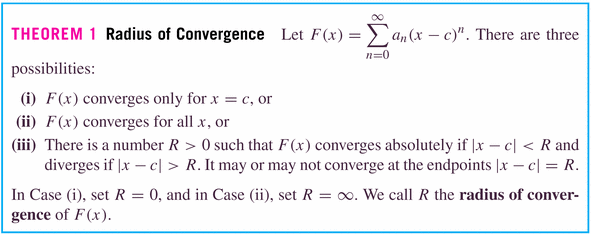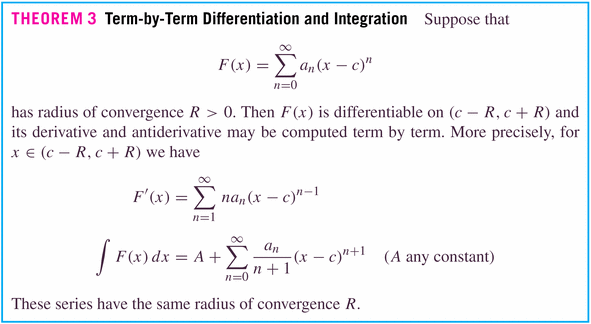- Exam revisions graded, sort of: I'd like to make appointments to talk to each of you about your exams. If you'll come in to discuss your redo, I'll guarantee a 100% on the redo. Email me to schedule a meeting (Please use subject line REDO).
- Homework for section 11.3 -- Sorry: my grader has promised to slip the homework under my door first thing tomorrow morning, and then I'll post it on my door (if you're eager to get it!).
- Homework for 11.4 has been pushed back to next time, 10/29.
- Homework for 11.5 -- let's push that back to 11/03, since we didn't get finished last time.
- There are two main results (theorems) in section 11.5. They are
two tests for convergence of series:

This result says that eventually the ratio of successive terms is effectively constant,
: what kind of series looks like that? A geometric series:
- #1, p. 574
- #5, p. 574
- #8, p. 575
- #13, p. 575

This result says that eventually the absolute values of the terms are effectively equal to
: what kind of series looks like that? A geometric series!
No wonder the results of the tests look exactly the same.... Too bad Rogawski didn't just use the same letter for the limits in both cases!
Notice that, once again, limits of sequences plays an important role! Series are just sums of sequences, after all; we're focused on how terms behave (root test), how successive terms behave (ratio test), or how partial sums behave.
Examples:
- #34, p. 575
- #36, p. 575
- Pick any....
- Now, rather than simply infinite sums of numbers, we're going to
consider an infinite sum of functions in what are known as
power series. They're like polynomials, but they don't
have finite degree.
The terms will be monomials -- constants times powers of x.
We've been sneaking up on these: we started by talking about Taylor series polynomials, which are generalizations of the linearization, or linear approximation (which has the tangent line as its graph).
Then we seemed to switch gears, and began talking about adding up infinite sequences of numbers.
Now we realize that, with functions for terms, each value of x specified gives rise to an infinite series, and we might immediately wonder if the series is convergent.
So what kind of function has an infinite number of terms? How do you evaluate such a thing? What kinds of function are these? It turns out that a lot of our old friends can be expressed this way --
, for example, as we've seen.
Now what did we assert about
? That
For what values of x would this converge?
Apply the ratio test for arbitrary x, and what do you discover?

So
presents us with a case where we have an "infinite radius of convergence".
Let's look at an example where our radius of convergence is not so nice: consider
If we construct the terms of the Taylor series polynomial as we did in section 9.4, via the equation
And then set a=0 (MacLaurin series), and note that all the derivatives evaluated at 0 are n!, then we see that
Now: for what values of x do you think that this will converge? And why does it make sense?


Note that this is a variant on the theme of the ratio test: we don't consider the power terms, but only the coefficients.
- Examples:
- What does Theorem 2 say will be the radius of
convergence of the series for
?
- What about the endpoints?
- #3, p. 585
- #8, p. 585
- #21, p. 585

- What does Theorem 2 say will be the radius of
convergence of the series for
- Examples:
- What do we get when we differentiate the series
for
term-by-term?
- What do you get when you integrate
? How can we find a power series for this function?
- We can use one series to find the power series
expansion for another series. What would be the power series
for
? What would be the power series of its anti-derivative(s)?
- #40, p. 586
- #47, p. 586 (a harder one! But good practice for manipulating power series, and to show why they're useful).
- What do we get when we differentiate the series
for